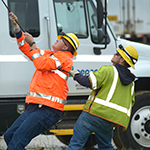 We have made preparations for the 2015 hurricane season and remind customers to prepare for the possibility of damaging severe storms that could hit the region any time between now and Nov. 30. The National Oceanographic and Atmospheric Administration (NOAA) says the 2015 Atlantic hurricane season activity will likely be below normal but warns that coastal areas could see storms. For the six-month hurricane season, which began June 1, NOAA predicts a 70 percent likelihood of six to 11 named storms with winds of 39 mph or higher. Three to six of those storms could become hurricanes with winds of 74 mph or higher, including two major hurricanes with winds of 111 mph or higher.
We have made preparations for the 2015 hurricane season and remind customers to prepare for the possibility of damaging severe storms that could hit the region any time between now and Nov. 30. The National Oceanographic and Atmospheric Administration (NOAA) says the 2015 Atlantic hurricane season activity will likely be below normal but warns that coastal areas could see storms. For the six-month hurricane season, which began June 1, NOAA predicts a 70 percent likelihood of six to 11 named storms with winds of 39 mph or higher. Three to six of those storms could become hurricanes with winds of 74 mph or higher, including two major hurricanes with winds of 111 mph or higher.
“Pepco continues to invest in enhancing the reliability of our electric system with a focus on fewer and shorter outages, but customers should always take steps to be ready for emergencies,” said Donna Cooper, Pepco region president. “Our storm readiness includes implementing a more efficient process to better manage crews, providing more accurate restoration times by area and improving communication with all customers.”
Storm readiness is also a year-round job for NOAA, which is responsible for tracking weather systems and providing the public with data, including hazardous weather alerts through the National Weather Service.
“Whether there’s one hurricane in the Atlantic or 25, it’s all a matter of whether a storm strikes our area,” said Chris Strong, National Weather Service warning coordination meteorologist. “We need to be ready for four threats: flooding rains, tornadoes, extreme high tides and wind damage.”
Pepco’s overall 2015 storm readiness includes:
- Advanced metering technology that limits the amount of times it is necessary to send a truck with a crew to inspect an individual customer’s service. Pepco’s control center is now able to view metered service remotely, which reduces our carbon footprint and reaches larger known outages sooner.
- 150 permanent line personnel and 250 contract line personnel on the system and ready to respond to emergencies.
- A continuously updated free mobile app with interactive outage maps and more accurate restoration estimates to provide a convenient way for customers to get more information and reach us in the event of an outage. Our mobile app is available at http://www.pepco.com/mobileapp.
- An enhanced website outage map that provides more detailed views of outage situations and improved methods of providing estimated times of restoration.
Since 2010, nearly 8,200 miles of trees trimmed to enhance the reliability of Pepco’s system. - Some immediate tips to help customers to prepare are:
- Assemble an emergency storm kit, including:
o Battery-powered radio or television
o Flashlight
o First-aid kit
o Battery-powered or windup clock
o Extra batteries
o Special needs items, such as an insulated cooler
o A list of important and emergency phone numbers
- For people using life-support equipment that requires electricity to operate, please identify a location with emergency power capabilities and make plans to go there.
- Keep at least a three-day supply per person of non-perishable foods and bottled water, as well as a hand-operated can opener.
- Have a telephone with a cord or a cell phone to use as a backup. Cordless telephones require electricity to operate and won’t work if there is an outage.
- Protect electronic equipment. Unplug sensitive electronics or plug computers and other sensitive equipment into surge suppressors and consider an uninterruptible power supply for temporary battery backup power.
- Turn off power to flood-prone basement appliances if it is safe to do so. However, if using an electrically operated sump pump, the customer should not turn off the power.
- Have adequate prescription medicines or infant supplies on hand.
- Tune to local news broadcasts for the latest weather and emergency information and follow the advice of their local emergency management officials.
If using a personal generator, please take all recommended precautions, including:
- Never use a generator indoors or in an attached garage. A portable generator is an internal combustion engine that exhausts a deadly gas called carbon monoxide or CO. Be sure to place the generator outside where exhaust fumes will not enter into enclosed spaces.
- Don’t connect your generator directly to your home’s wiring. If a generator is plugged into the electrical circuits of a home, it can back feed power into the utility company lines, which can injure or kill utility workers fixing downed power lines. It also can cause downed lines to re-energize.
